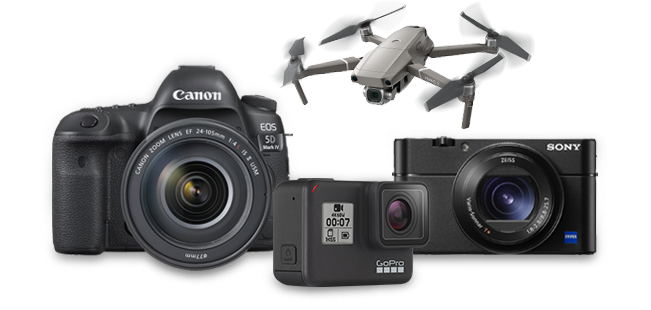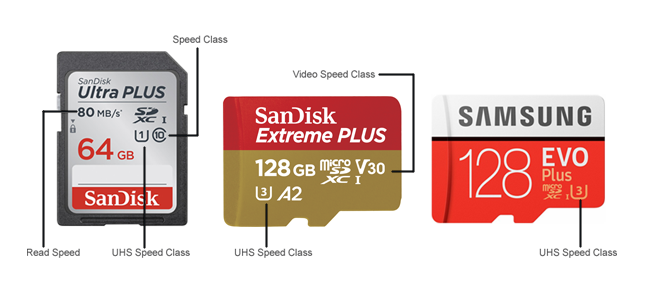
Memory cards
Buying Guide
Topics in this buying guide:
Choosing the right memory card.

The most prominent factor in choosing a memory card is what device you'll be using it in. Most devices have a specific set of memory cards that are compatible with them. A smartphone or tablet may have only one slot, while a higher-end DSLR or mirrorless camera can have several. Check your device or owner's manual, and take note of what formats you'll be able to choose from.
Once you know what formats you can pick from, you'll want to think about what you'll be using your device to do. Different tasks require varying amounts of card capacity and write speed (both explained below):
Basic pictures and data
If your smartphone, tablet or entry-level point-and-shoot camera has a memory card slot, you may opt to add a memory card to store your photos, videos, and other data like apps or music. In these cases, you will be more concerned about the card's storage capacity than its speed. Though they are small, microSD cards can offer large capacities of 128GB and more. Whichever size card you're interested in, you'll want to make sure before you buy that your device will support that capacity.
Photos of family, friends and fun
If you're planning to store photos and videos on your memory card, you may need to consider write speed as well as capacity. If your photography needs are fairly basic, such as taking clear, quality pictures of family vacations or get-togethers, any average memory card, like a Speed Class 10, should provide sufficient speed and reliability. However, if you plan on taking video including 4K Ultra HD or HRD, you'll require faster speed and more capacity.
Video and high-speed photos
Faster, more sophisticated cameras and camcorders, such as DSLR and mirrorless cameras, action cams, and even high-end point-and-shoot cameras have more capabilities that require different features from a memory card. HD, 4K Ultra HD, slow motion and high-speed burst shots require a lot faster speed and greater capacity from a memory card. To properly store these files, you'll need cards with a higher write speed to keep up (see Write Speed below for more information). A memory card with higher write speeds will help prevent camera lag, recording failures and other performance issues. Larger memory card capacity will provide ample space for high-resolution photos and video so you won't run out of memory when it matters most.
How to determine your card's attributes.

Memory card formats and compatibility.
As discussed above, the memory card options available to you are limited by the device you are using it in. Each device has a discrete set of compatible card choices. Check your device carefully, as many cameras have multiple memory card slots, giving you more options of what cards you can use.
Secure Digital (SD) and microSD memory cards
The majority of new cameras, camcorders and other devices use Secure Digital (SD) or microSD memory cards. MicroSD is the smaller variant of the SD memory card and, because of its compact size, microSD is used in certain mobile devices as well.
If your device is able to use a Secure Digital High Capacity (SDHC) and Secure Digital eXtended Capacity (SDXC) card, you'll be able to store substantially more photos and videos than traditional SD cards. However, these formats are not backward compatible.


CompactFlash, CFast and XQD memory cards.
CompactFlash cards are the oldest memory card format still in normal use. While not very common in most cameras currently available on the market, they can sometimes be found in top-end professional models. Higher write speeds mean that these cards are ideal for high-resolution video or burst photography.
Another memory card type used in top-end professional cameras and camcorders is CFast. A variant of CompactFlash, this memory card format has an extremely fast write speed and can be used in cameras that capture the highest quality images and video.
The latest format for top-end cameras and camcorders is XQD. Even faster than CFast, it has the fastest write speed of all. Found in select top-end cameras, XQD is PCIe based, and doesn't have the same speed limitations as CFast or CompactFlash. Often a top-end camera will use either CFast or XQD, but not both.
Memory card capacity.
If you're an amateur photographer, or just starting out, chances are the most important factor in a memory card will be capacity. The capacity is measured in gigabytes(GB) and determines how much your card can hold. A higher capacity can help you if you'll be taking photos on a trip and are unable to transfer them onto a computer, or if you will be taking high-definition photos to be used for print making.
If you're planning to use your camera, smartphone or camcorder to take high-resolution video, such a 1080P or 4K UHD, you'll want to make sure you have a large capacity card to avoid needing to empty it after a small amount of footage.
The most common memory cards typically come in 8GB, 16GB, 32GB, 64GB and 128GB capacities. However, some high-capacity cards can now hold terabytes (TB) of data. One TB is equal to 1,000GB. Often these larger memory cards are SDXC cards, so you'll want to check your device and make sure it's compatible with these cards before purchasing.
If you're working with a top-end camera or camcorder, your device may be compatible with larger cards, such as CompactFlash, CFast or XQD. These cards are made to hold more of the larger files your device can produce.

Shop microSD and SD cards by capacity

The need for speed.
When dealing with larger, high-resolution files, you may think that capacity is your first concern. However, the speed of a memory card plays a huge part when filming 4K video, taking large print-quality photos, and taking rapid burst shots. This type of photography may require a higher write or read speed in order to process data quickly. When looking at memory cards, it's important to delineate write speed and read speed and make sure you get what works best for each.
Read speed
Read speed determines how fast data can be retrieved from the card. A faster read speed means you can more quickly transfer data from the card onto a computer or printer. Faster read speeds decrease your wait time so you can edit, save and share faster. For example, if you were shooting weddings, or doing work where you'd have to download a large amount of large raw image files to the computer, you'd want a higher read speed. However, read speed is really more of a convenience, whereas your primary focus should be write speed when you're looking for a memory card.
Write speed
Write speed is how fast images can be saved onto a memory card. This is a critical need, especially if your camera takes high-resolution images, burst pictures or HD video. If you have a slower memory card, you may have to wait for the memory card to finish writing before you can take additional shots, which could cause you to miss the perfect photo. If your card is too slow to properly handle video, it may cause dropped frames, inferior quality, or stop recording altogether. So if you're doing sports photography, or taking video, make sure to look for a higher write speed.
Speed class, ultra high speed class and video speed class
Speed class:Speed class is a minimum sustained writing performance speed for SD cards. This means that it's the speed it can write data to the card consistently. Speed class is mainly useful when you're shopping for a card to use with video recording, since you'll be continuously writing to the card. The higher the speed class, the more data you can write to the card in the same amount of time. Pay attention to this when deciding what card you need for the desired resolution you'd like to film in.
Ultra high speed class:
UHS speed class is designed for SDHC and SDXC memory cards. These cards are a higher speed and utilize a different data bus that doesn't work in non-UHS compatible devices. You'll want one of these cards for Full HD recording and for taking continuous high-resolution photos, like burst shot mode used for sports photography. A higher speed UHS card, like a U3 can be used for recording video in 4K.
Video speed class:
Video speed classes are added to the faster SD card arsenal. For example, a UHS speed class of 3 is a V30 video speed class. Most often shown starting with the 90MB/sec and 60MB/sec cards, they allow additional features to make writing more even and assure consistent performance. These speed classes are a perfect way to understand cards for the latest video capabilities such as 8K video, 3D recording, video streaming and more.
Shop microSD and SD cards by speed
Memory card accessories.
Card readers and adapters
Your computer may not have the right memory card reader built in, or have any card reader at all. Card readers are simple-to-use, portable attachments you can plug in to a USB port to transfer your photos and videos from your memory card. Card readers come in a wide variety with different combinations of memory card ports.
Also, some cards can slip into adapters in order to work in noncompatible devices. The most common adapters allow microSD cards to work in devices that have only an SD card slot.
Shop for memory card readers and adapters ›
Storage cases
Memory cards, just like your electronics, are an investment. You may want to take added steps to protect them. Plus, cases can help organize multiple memory cards while keeping them handy. Cases come in a wide variety, from simple plastic cases for individual cards to multicard aluminum organizers.


Shop online or in store.
Find a broad range of memory cards and accessories at BestBuy.com. Your local Best Buy store also has a selection of memory cards. Plus, our friendly Blue Shirts are there to answer questions and help with choosing the best memory card for your needs.